| Article ID | Journal | Published Year | Pages | File Type |
|---|---|---|---|---|
| 8105779 | Journal of Cleaner Production | 2014 | 12 Pages |
Abstract
The production phase of cotton yarn provides an impact equal to 2.81 CO2 kg-equivalent. The most critical impacts of cotton yarn production are due to Dyeing (1.24 CO2 kg-eq.) and Spinning (0.64 CO2 kg-eq.) phases and they are essentially connected to reactive reagents and pigments, electrical and thermal energy. Regarding thermal energy consumptions some improvements in dyeing plants (recover cooling water, return steam condensate to boilers or reuse different process waters) may allow the company to decrease in CO2 emission by 41.7%. Moreover a reduction in CO2 emission by 34.6% can be achieved in the spinning phase using an optimized suction tube in conjunction with adjustable inverter control.
Related Topics
Physical Sciences and Engineering
Energy
Renewable Energy, Sustainability and the Environment
Authors
Maurizio Bevilacqua, Filippo Emanuele Ciarapica, Giovanni Mazzuto, Claudia Paciarotti,
